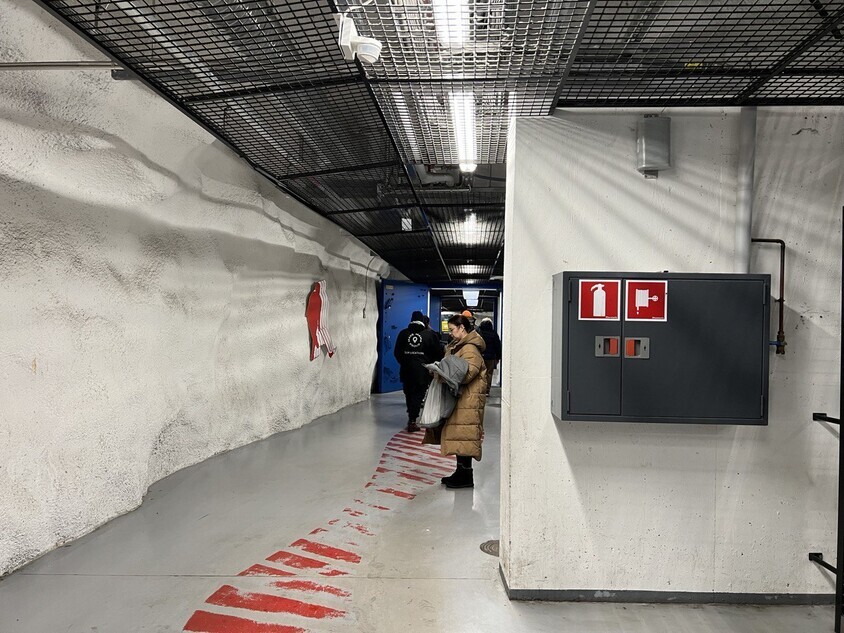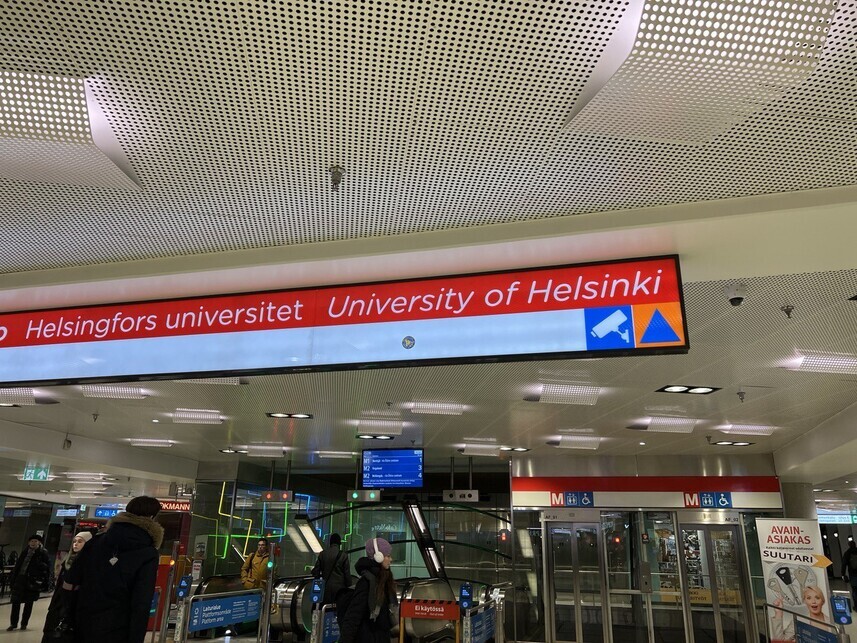hankyoreh
Links to other country sites 다른 나라 사이트 링크
New Cold War comes for Europe as nations abandon neutrality and ramp up military buildup

Since it began nearly one year ago on Feb. 24, 2022, the war in Ukraine has shaken the global order in fundamental ways.
For this three-part series, the Hankyoreh visited countries in Europe to see how the war has led them to alter the security postures they have maintained for over seven decades since World War II. Finland and Sweden, two Northern European countries that have long remained neutral, made the decision to join NATO, and Western forces have been forward deployed in the three Baltic republics — small countries that share borders with Russia.
Germany, which had been concealed underneath the security umbrellas of the US and NATO, declared a “change in eras” and announced its plans to adopt a new course of beefing up its military capabilities, which it had shied away from doing in the seven decades since WWII.
The first installment looks at Finland’s decision and the grim reality of territorial issues, which have been the key bone of contention in the recent war.
At 1:45 pm on Feb. 17, more than 500 heads of state and top diplomats and security officials from around the globe were waiting with bated breath to hear the person dubbed “David on the Dnipro.” They were in Munich, in the German state of Bavaria, to attend the world’s largest security conference.
When the conference started, Volodymyr Zelenskyy appeared on a large screen that was set up at the front of the conference room. The Ukrainian president made his virtual address for a panel at the Munich Security Conference called “David on the Dnipro: Ukraine’s Fight for Freedom.” Russia — the Goliath to Ukraine’s David — wasn’t invited to this year’s conference, for the first time in 24 years.
“Last year, when I was here in Munich at the Conference, I was looking for [. . .] common determination,” Zelenskyy said. “I wanted to hear from the world: Ukraine, we will be with you. Unfortunately, I heard it only after Russian missiles struck our land.”
“Delay has always been and still is a mistake,” he went on.
Friday, Feb. 24, will mark exactly one year since the war in Ukraine began with Russia’s full-scale invasion of the country.
“And this is not a war in Ukraine, but a war in Europe,” Zelenskyy said in his speech on Feb. 19, 2022, during last year’s Munich Security Conference, referring to eight years of fighting in Ukraine’s Donbas (the Donetsk and Luhansk regions) following Russia’s annexation of the Crimean Peninsula in March 2014.
Just as Zelenskyy predicted, the war begun by Russian President Vladimir Putin has rocked the security alignment not only of Europe but of the world over the past year. It has caused energy prices to surge, bringing the worst inflation in forty years, and wrought subtle changes in the US and China’s intense strategic competition.
Numerous analysts offer the gloomy prognosis that this war will embroil the world in a “new Cold War” that will be similar to the Cold War between the US and the Soviet Union, representing the West and the East.
Everything has changed over the past year. While the US and Europe were initially hesitant to provide full support to Ukraine, they have made an about-face and are now pouring an immense amount of military support into the country.
During the conference, Western leaders promised to keep providing military aid for “Ukraine’s victory” for “as long as Ukraine needs it.”
The Hankyoreh’s first stop was Finland, a neutral country sharing a 1,340km (832-mile) border with Russia and the country that was shocked the most by the war.
On the afternoon of Feb. 11, I visited a shelter in Sörnäinen, a neighborhood in the Finnish capital of Helsinki, that was marked with a blue triangle inside an orange square, the international symbol of civil defense.

The stairway leading underground was locked tight, so I took the elevator down, emerging into a cavernous tunnel. The area was clearly illuminated by bright lights and stocked with fire extinguishers, with a sign marking the location of the emergency exit.
Walking down the tunnel for about 100m, I was surprised to find a sports center. The area, which was 4.5m high and 21m across, had fields for football and field hockey that children are allowed to use at any time.
In ordinary times, this underground area, about 20 m below the surface, serves as a public athletic facility. But in a war or another crisis, it could be prepared for use as a shelter within 72 hours.
Finnish law states that shelters must be built in buildings with a total floor area of at least 1,200 square meters (1,500 m2 for commercial buildings). In case of an emergency, those shelters must also be made ready to house civilians within three days.
The Finnish Ministry of the Interior announced on Feb. 9 that there are around 50,500 shelters where civilians can take refuge in a crisis throughout the country. That’s enough to house 4.8 million people, or 87% of the country’s population of 5.53 million.
In the capital of Helsinki, bomb shelters and other places of refuge have a capacity that is 34% greater than the total city population. Around 85% of those shelters were built after 1971.
The Finnish government’s disclosure of the latest shelter figures indicates how fears about security have grown over the past year. Since March, shortly after the outbreak of war in Ukraine, Finns have been fiercely debating whether they have the capacity to deal with a crisis.
Local newspapers have pointed to serious issues with some of the shelters, which are flooded or lack proper electricity. Acknowledging the issues, the government launched a survey of the shelters, with the final report due in August.
Another initiative by the Finnish government has been its historic decision to join NATO. To the east, Finland has a long border with Russia, and its northern border abuts the Russian naval base at Murmansk, home to the nuclear submarines of Russia’s Northern Fleet. Helsinki, the Finnish capital, is just 300 km away from Saint Petersburg, Russia’s second-largest city.
Those geopolitical factors precipitated the Soviet Union’s invasion of Finland in November 1939, at the beginning of World War II, leading to a 105-day conflict known as the Winter War. On March 12, 1940, the two sides signed the Moscow Peace Treaty, ending the war, but Finland had to cede Karelia and Salla, an area of 35,084 square kilometers, to the Soviet Union.
Memories of that time are still traumatic for the Finns, who opted for the path of neutrality to ensure they would not get tied up in further foreign conflicts.
But the shock of Russia’s invasion of Ukraine was so great it caused Finland to abandon a policy line it had maintained for nearly 80 years in the postwar period. In April, just two months after the invasion, the foreign press began reporting that Finland was mulling a bid to join NATO. A month later, on May 18, Finland and Sweden submitted their official applications for membership in the alliance.

Finnish Prime Minister Sanna Marin explained the country’s decision to join NATO during a talk at the Munich Security Conference on Feb. 18.
“When Russia, our neighbor, attacked another neighbor, Ukraine, it was obvious that Finland will join NATO,” she said, explaining that the security provided by NATO membership is “the only line that Russia won’t cross.”
“In all honesty, things have gotten scarier since Russia’s invasion of Ukraine last year. I don’t know why we haven’t joined NATO yet,” said Markku, a 67-year-old Helsinki resident whom I spoke to in front of a bomb shelter in the city.
Finland has also moved to boost its defense spending. The country announced last September that it will spend 6.1 billion euros on defense in 2023, up 20%, or 1 billion euros, from 2022.
“We’re making unprecedented investments in security,” said then-Defense Minister Antti Kaikkonen in January 2022, emphasizing how military tensions are on the rise in Europe.
As a result, Finland’s defense spending will go up from 1.96% of its GDP in 2022 to 2.25% this year.
The Finnish government’s 2023-2026 fiscal plan, which came out in April 2022, also shows how the war has heightened a sense of crisis.
Noting that the impact of Russia’s invasion of Ukraine will continue to reverberate and that the security situation is tense and unpredictable, the Finnish government assumed that military operating costs will increase by 130-200 million euros a year and allocated 163 million euros to purchase patrol planes for its border guard.
Last February, just before the war broke out, Finland signed an arms deal with the US worth 8.4 billion euros that includes 64 F-35A fighters.
Circumstances are much the same in Sweden, which has also decided to join NATO. While Sweden’s defense spending amounted to just 1.45% of its GDP last year, it intends to raise that to 2% by 2026.
Jakob Hallgren, director of the Swedish Institute of International Affairs and former Swedish ambassador to South Korea and ambassador for disarmament and nonproliferation, explained why his country has decided to set aside neutrality and join NATO.
“[Russia’s invasion of Ukraine] signifies that the order that lasted for around 70 years after World War II is no longer applicable. In the spring of 2022, even the Social Democrat Party abandoned its firm support of nonalignment. If Russia is capable of invading Ukraine, then Finland, Belarus, Moldova or Poland could be next.”
By Noh Ji-won, Berlin correspondent
Please direct questions or comments to [english@hani.co.kr]

Editorial・opinion
![[Column] Has Korea, too, crossed the Rubicon on China? [Column] Has Korea, too, crossed the Rubicon on China?](https://flexible.img.hani.co.kr/flexible/normal/500/300/imgdb/original/2024/0419/9317135153409185.jpg) [Column] Has Korea, too, crossed the Rubicon on China?
[Column] Has Korea, too, crossed the Rubicon on China?![[Correspondent’s column] In Japan’s alliance with US, echoes of its past alliances with UK [Correspondent’s column] In Japan’s alliance with US, echoes of its past alliances with UK](https://flexible.img.hani.co.kr/flexible/normal/500/300/imgdb/original/2024/0419/2317135166563519.jpg) [Correspondent’s column] In Japan’s alliance with US, echoes of its past alliances with UK
[Correspondent’s column] In Japan’s alliance with US, echoes of its past alliances with UK- [Editorial] Does Yoon think the Korean public is wrong?
- [Editorial] As it bolsters its alliance with US, Japan must be accountable for past
- [Guest essay] Amending the Constitution is Yoon’s key to leaving office in public’s good graces
- [Editorial] 10 years on, lessons of Sewol tragedy must never be forgotten
- [Column] A death blow to Korea’s prosecutor politics
- [Correspondent’s column] The US and the end of Japanese pacifism
- [Guest essay] How Korea turned its trainee doctors into monsters
- [Guest essay] As someone who helped forge Seoul-Moscow ties, their status today troubles me
Most viewed articles
- 1[Column] The clock is ticking for Korea’s first lady
- 2After 2 months of delayed, denied medical care, Koreans worry worst may be yet to come
- 3[Column] Has Korea, too, crossed the Rubicon on China?
- 4US overtakes China as Korea’s top export market, prompting trade sanction jitters
- 5[Correspondent’s column] In Japan’s alliance with US, echoes of its past alliances with UK
- 6[Editorial] When the choice is kids or career, Korea will never overcome birth rate woes
- 7Hong Se-hwa, voice for tolerance whose memoir of exile touched a chord, dies at 76
- 8All eyes on Xiaomi after it pulls off EV that Apple couldn’t
- 9More South Koreans, particularly the young, are leaving their religions
- 10John Linton, descendant of US missionaries and naturalized Korean citizen, to lead PPP’s reform effo